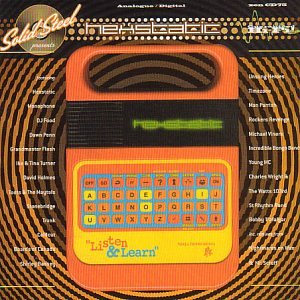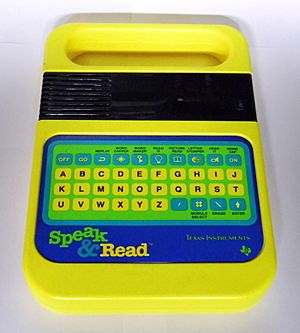- This page was last modified on 15 June 2025, at 00:30. Suggest an edit.
Speak & Spell (toy) facts for kids
 An American 1979-model Speak & Spell with chiclet keyboard |
|
| Type | Electronic handheld |
|---|---|
| Company | Texas Instruments, Basic Fun |
| Availability | 1978–1992, 2019- Present |
| Materials | Plastic |
The Speak & Spell is a cool electronic toy from Texas Instruments. It's like a small computer that helps kids learn to spell. It has a keyboard and a screen. The best part is its special voice!
This toy was one of the first handheld devices with a screen that could use different game cartridges. It came out in 1978. In 2019, a company called Basic Fun brought it back, but with some new changes. The Speak & Spell was even named an IEEE Milestone in 2009, which is a big honor for its technology.
Contents
How the Speak & Spell Was Made
The Speak & Spell was created by a small team of engineers at Texas Instruments (TI). This happened in the late 1970s. They started working on it in 1976.
TI was already researching how to make computers "talk." The Speak & Spell was a result of this work. It used a special technology called "Solid State Speech." This meant it could store whole words as electronic data. This was a big deal! Before this, talking toys used tapes or records for sounds. The Speak & Spell was the first educational toy to use electronic speech.
Exploring the Speak & Spell Toy
The First Speak & Spell
The original Speak & Spell was part of a series of talking toys. This series also included the Speak & Read and Speak & Math. These toys were made to help kids learn.
The Speak & Spell was designed to help kids aged 7 and up. It taught them to spell and say over 200 common words. When you bought it, it came with some built-in games. These games were Mystery Word, Secret Code, and Letter.
Later Speak & Spell Versions
Over the years, the Speak & Spell changed a few times. In 1982, a smaller version called the Speak & Spell Compact came out. This one didn't have a screen.
In 1989, the Super Speak & Spell was released. This version had a new screen. It used an LCD screen instead of the older VFD screen. The keyboard also changed to a QWERTY layout, like a regular computer keyboard. The Super Speak & Spell had a different shape too, with the handle at the bottom.
There were also different versions of the Speak & Spell for other countries. These versions spoke different languages. For example, there were versions for English (American and British), Japanese, German, French, Italian, and Spanish.
The 2019 Speak & Spell
In 2019, the company Basic Fun started making the Speak & Spell again. This new version has some differences from the old one.
The biggest change is the voice. The original toy had a unique computer-generated voice. The new one uses recorded voices that are made to sound like the old one. The 2019 model also has a different screen. It uses a segmented LCD screen. Also, the new Speak & Spell does not use extra game cartridges anymore.
How the Speak & Spell Works
The Speak & Spell used a special computer chip. This chip was called the TMC0280, or later, the TMS5100. It was the first chip that could create speech all by itself. It used a clever method called linear predictive coding (LPC).
The words the Speak & Spell spoke were stored on special memory chips. These chips held a lot of information. To create the words, professional speakers would record them. Then, engineers would process these recordings. They made the sounds fit into the small memory chips. This process was very detailed and sometimes difficult. The Speak & Spell could speak about 1,000 bits of information per second.
The original Speak & Spell had a vacuum fluorescent display (VFD) screen. This screen showed the letters. Later models, like the Super Speak & Spell, used a slimmer case and an LCD screen instead. The toy could run on 4 "C" batteries or a 6-volt power adapter.
Speak & Spell Game Cartridges
The Speak & Spell used special cartridges. These were like small memory cards. You could plug them into the toy. They added new words and games. The cartridges fit into a slot near the battery area.
Each cartridge had different words and games. The words were chosen to help kids learn. There were different cartridges for different languages. For example, there were separate ones for American English and British English. Educators in each country helped choose the word lists.
| Console | Module title | Date | Color |
|---|---|---|---|
| Speak & Spell (1978) | Basic Unit (not a cartridge) | 1978 | N/A |
| Vowel Power | 1978 | Red | |
| Super Stumpers 4–6 | 1979 | Red | |
| Super Stumpers 7–8 | 1979 | Red | |
| Basic Builders | 1979 | Red | |
| Mighty Verbs | 1979 | Red | |
| Speak & Spell (1978, UK) | Vowel Power | 1978 | Red |
| Mighty Verbs | 1979 | Red | |
| Speak & Spell (1980) | Homonym Heroes | 1980 | Red |
| Noun Endings | 1980 | Red | |
| Magnificent Modifiers | 1980 | Red | |
| Vowel Ventures | 1980 | Red | |
| E.T. Fantasy Module | 1982 | Red | |
| La Dictée Magique | Les Mots De Base Module No 1 | Red | |
| Les Mots Difficiles Module No 2 | Red | ||
| Les Animaux Familiers | Red | ||
| Les Magasins De La Rue Module No 4 | Red | ||
| Les Extra-Terrestres Module No 5 | Red | ||
| Grillo Parlante | SuperModulo | Red | |
| Super Speak & Spell | Words, Words, Words | Yellow | |
| Words Around Us | Gray | ||
| Expansion 3 | Blue | ||
| El Loro Parlanchín | Módulo de Extensión No 1 | 1990 | Blue |
| La Super Dictée Magique | Module d'Extension Anglais 1 | 1991 | Blue |
| Module d'Extension No 2 | 1991 | Blue |
Here are some examples of games you could play with Speak & Spell cartridges:
- Say It – The toy says a word, and you have to spell it.
- Mystery Word – This is like an electronic version of the game Hangman.
- Secret Code – You type a word, and the Speak & Spell turns it into a secret code.
- Letter – This game lets you change a word by shifting its letters in the alphabet.
- Drop It – (Super Speak & Spell) Learn how new words are made by adding beginnings and endings.
- Memory – (Super Speak & Spell) Test your memory and how well you recognize letters.
- Mix Up – (Super Speak & Spell) Explore word patterns and how letter sounds relate to spelling.
- Same As – (Super Speak & Spell) Learn about words that sound alike but have different meanings (like "to," "too," and "two").
Speak & Spell's Impact
In Music
The Speak & Spell has been used in music! Some musicians use its original sounds. Others modify the toy to create new sounds.
Artists like Jean Michel Jarre have used sounds from the Speak & Spell's opening. Many electronic music artists use its voice in their songs. You can hear Speak & Spell sounds in songs by Beck, Coldplay, Röyksopp, Robyn, and Kraftwerk. Even pop and hip hop artists have used it.
The English band Depeche Mode even named their first album, Speak & Spell, after the toy.
Circuit Bending
Some musicians like to "circuit bend" the Speak & Spell. This means they open the toy and change its electronic parts. They add switches and knobs. This makes the Speak & Spell create new, unexpected sounds. It's a way to turn the toy into a unique musical instrument.
Artists like Beck and Venetian Snares have used circuit-bent Speak & Spells in their music.
Other Speak & Spell Toys
Speak & Read Series
The Speak & Read came out in 1980. It looked like the Speak & Spell but was yellow. It focused on helping kids aged 4–8 with reading. It had over 250 basic words. Its cartridges only worked with Speak & Read units.
Later, the Super Speak & Read was released in 1988. It had a new flip-open design. It also used different, thinner cartridges.
Speak & Math Series
The Speak & Math was released in 1980. It looked similar to the Speak & Spell but was gray. It helped kids aged 6–12 with math. It had over 100,000 math problems.
In 1990, the Super Speak & Math came out. Like the Super Speak & Spell, it had an LCD screen. It also had an expanded keyboard.
Other Talking Toys
Texas Instruments made other toys using similar speech technology. These included:
- Speak & Learn Magic Wand – A game that used a special wand to read barcodes.
- Speak & Music – A musical game that let you create and remember rhythms.
- Ready... Set... Read! and Magic Reading Desk – These were similar to the Speak & Read.
- Little Maestro – A music game for younger children.
Images for kids
-
A 1978-model Speak & Spell was used as the "phone home" device in the 1982 movie E.T. the Extra-Terrestrial.





